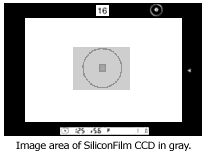2001: I’m a 35mm photographer from way back. Much as I’d love a digital camera that takes my Nikon lenses, until now they’ve been preposterously expensive. So I use a wonderful little Canon PowerShot A50 for digital shots and my Nikon N6006 when I want more control.
I’ve been following SiliconFilm ever since it was announced. It’s nice to see they’re now taking orders. However, a few points must be mentioned.
What Is SiliconFilm
![]() SiliconFilm is a clever product that fits inside select existing 35mm SLRs in place of film. It uses a CCD to produce a 1.3 megapixel (MP) image and has the same sensitivity to light as ISO 100 film.
SiliconFilm is a clever product that fits inside select existing 35mm SLRs in place of film. It uses a CCD to produce a 1.3 megapixel (MP) image and has the same sensitivity to light as ISO 100 film.
The bulk of SiliconFilm is about the same size and shape as a 35mm film cartridge, with the CCD sticking out the side like a film leader. The beauty of SiliconFilm is that it doesn’t require any modification of the camera or a special camera back.
For $649-699, it’s a novel and probably cost-effective way for Canon and Nikon users to go digital with their current lenses, flashes, accessories, and possibly cameras they already own.
“Select” 35mm SLRs
The “select 35mm SLR cameras” supported by SiliconFilm is a very small list indeed:
Canon
- EOS 1/1N/1V
- EOS A2/E
- EOS 5
Nikon
- F5
- N90/N90s
- F90/F90x
Not that it wouldn’t be nice to own a Nikon N90, but that’s a $700 camera body.* And then you have to add $649-699 for SiliconFilm. It probably makes for a nice $1,349-1,399 digicam, but that’s a lot more than I’m prepared to invest.
1.3 Megapixels
Sorry, but 1.3 MP just isn’t going to provide 8×10 quality. You can get a nice sharp 5×7 or smaller, possibly a decent 6×9, but as I discovered last week with my Epson Stylus Photo 870 and a 1.3 MP file from my PowerShot, an 8×10 built from 1.3 MP just isn’t as sharp as you want.
SiliconFilm Coverage

But the most frustrating feature of SiliconFilm is the limited area of the sensor – it uses about one-third the height and one-third the width of a 35mm frame (10.8 x 8.6mm, to be precise), making a 50mm lens act like a 150mm telephoto, a 28mm wide-angle act like an 85mm short portrait lens, and an “ultra-wide” 19-35mm zoom (my Vivitar Series I) only cover the equivalent of a 55mm normal lens when used at the widest zoom setting.
Conclusion
I’m hoping SiliconFilm – or someone else – can come to market with a nice 2-4 megapixel sensor that covers the entire 35mm frame. I do too much wide-angle work for any of the current Nikon digital SLRs to do me any good, and 1.3 MP just doesn’t offer the quality needed for serious photography. (It’s more than good enough for the Web, though.)
SiliconFilm is taking a promising first step at a pretty attractive price, but for a any of us who want sharp 8 x 10s or need wide-angle coverage, it’s not a big enough step to meet our needs.
* Once upon a time, I did own a Nikon N90. It was the German version sold to the camera store where I worked by an exchange student at a very reasonable price. This was hands down the finest camera I have ever owned.

